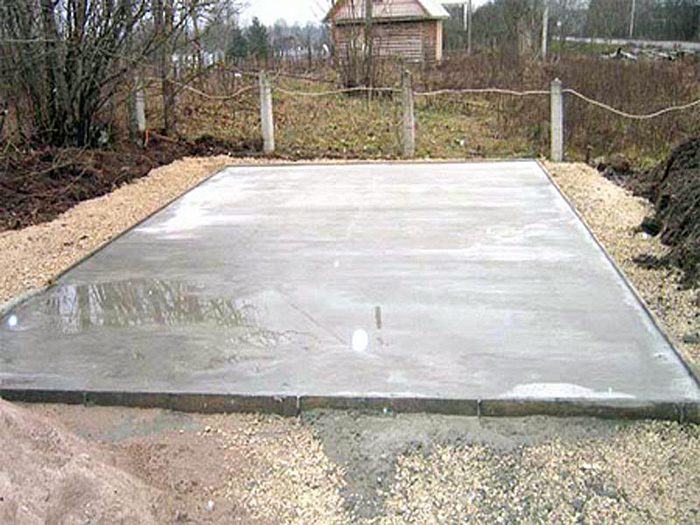Search
Login
How to make the calculation of the foundation for the house, the criteria for choosing the foundation
The foundation is the most important part of any structure. Mistakes in its construction are too expensive. To eliminate defects will require two to three times more money and effort than to erect it. And in some cases, this will not help, everything will end with the loss of the house. How to avoid mistakes? How to choose the type of foundation? How is the foundation for the house calculated? Our article is called upon to answer these questions.
Content
- Types of foundations
- How to determine soil properties
- How to choose the type and depth of the foundation
- How to calculate the foundation for a house video
Types of foundations

Foundations vary both in design and in laying depth. Three types of foundations are distinguished by laying depth:
- not deep, the base of which is located on the surface of the soil;
- partially buried, the base of which is above the level of freezing of the earth;
- buried, the sole of which is deeper than the level of freezing.

Structurally, foundations are of the following types:
- Continuous foundations - belong to the undecked types. They are a monolithic concrete or reinforced concrete structure. Such a foundation will compensate for the vertical movement of the soil with its area. Therefore, it is advisable to apply them on weak and prone to heaving soils.
- Columnar foundations have the form of individual supports (at the corners of the building, the intersection and abutment of the walls), i.e. such pillars are the main supporting structure of the building. This foundation is classified as a buried type. There are restrictions on the weight of the construction of the house.
- Tape is the most common version of the foundation. They can be either a buried type or a partially buried one. It is a continuous tape in the form of load-bearing supports for the walls of the building. It can also be made in the form of a tape under several separately standing supports.
- Pile foundation refers to the buried type. It consists of two parts: piles and grillages (a plate that connects piles in one structure). This type of foundation is used on unstable types of soil and quicksand.

Which one foundation better for home? The best one that is selected in strict accordance with the characteristics of your soil and precisely designed for the load of the entire structure of the house. And whether it will be tape, columnar or tape-columned is not so important.
How to determine soil properties

In order for the foundation and walls under their own weight and other loads to have uniform settlement, a uniform and dense soil is necessary. The following soil characteristics are important to us:
- bearing capacity of soil;
- tendency to swell;
- degree of drawdown;
- heaving of the soil.
To determine the bearing capacity of the soil, it will be necessary to use the standards of SNiPa 2.02.01-83, where approximate values \u200b\u200bof all types of soil are indicated.
Accurate determination of these characteristics at home is not possible. But, density (affects the tendency of the soil to swell), ductility and humidity can be determined independently (with an error of course).
Determine the density with a peg 5 cm thick:
- very dense soil in order to take a sample we need a pick or scrap;
- dense soil of the peg does not go deeper than 15 cm into the ground;
- loose soil count enters without much effort;
- very loose soil, you can easily make a depression in the soil with your finger.
The plasticity of the soil can be determined with a shovel. If, after excavation of a shovel from the ground, a significant part of it remains on it, such soil is considered plastic and fluid. So, he is prone to sediment.

Humidity is determined by the ease of scattering of soil in the hand. If the process of rubbing in the hand is light, the soil is dry, if it rolls into a wet lump. In winter-saturated soils, a partial rise of the soil occurs (winter).
How to choose the type and depth of the foundation

When calculating the foundation, choosing its type, it is necessary to take into account the forces that will affect it. The determining factors include:
- type and structure of soil;
- freezing depth of the earth;
- ground water level;
- design load at home.
For excessively heaving soils, it is advisable to use a solid type of foundation. This is the best foundation for a house built on such a ground. The slab compensates for vertical ground rises without harming the home. True, this type of foundation will cost much more than the same tape.
For rocky soils, any type of foundation is suitable.

For coarse soil, the laying depth of the foundation foundation should be at least 50 cm.
For sandy and clay soils, the depth of foundation laying should be no less than the depth of freezing of the soil (the normative depth is specified in SNiP 2.02.01-83). For these soils, only buried types of foundations are suitable.
How to calculate the foundation for a house

The height of the base in the strip foundations is allowed up to 1.2 m with a foundation width of 40 cm. By the way, in the UK they approach the determination of height easier, there the ratio is 1: 1. Those. the size of the aerial part of the foundation is equal to the size of the underground part.
As for the width, the calculation of the foundation for the house is done individually for each project. In the calculations, the weight of all building structures of the house, the weight of furniture, equipment, soil bearing capacity, wind load and rainfall are used. If simplified as much as possible, the width of the foundation should provide a load of not more than 70% of the bearing capacity of the soil.
If you want to make an approximate calculation yourself, you will need to find in the tables the weight and parameters of precipitation and wind load for your region (the same SNiP, etc.). All this summarize and multiply by a safety factor of 1.3.
We sum linear meters of the length of the foundation and translate them into centimeters. We find out the value of the bearing capacity of our soil (which is associated with the type and humidity of the soil). The width of the foundation is determined by the formula:
Foundation width \u003d load / length / soil bearing capacity
We examined the approximate calculation of the strip foundation, since it is the most common. Of course, in order to be sure of the foundation of the house and build for centuries, you still need the help of a specialist. At least to determine the exact structure of the soil. The rest can be calculated by yourself, only it is desirable to make a 30% margin of safety, because with self-designing figures are approximate.





